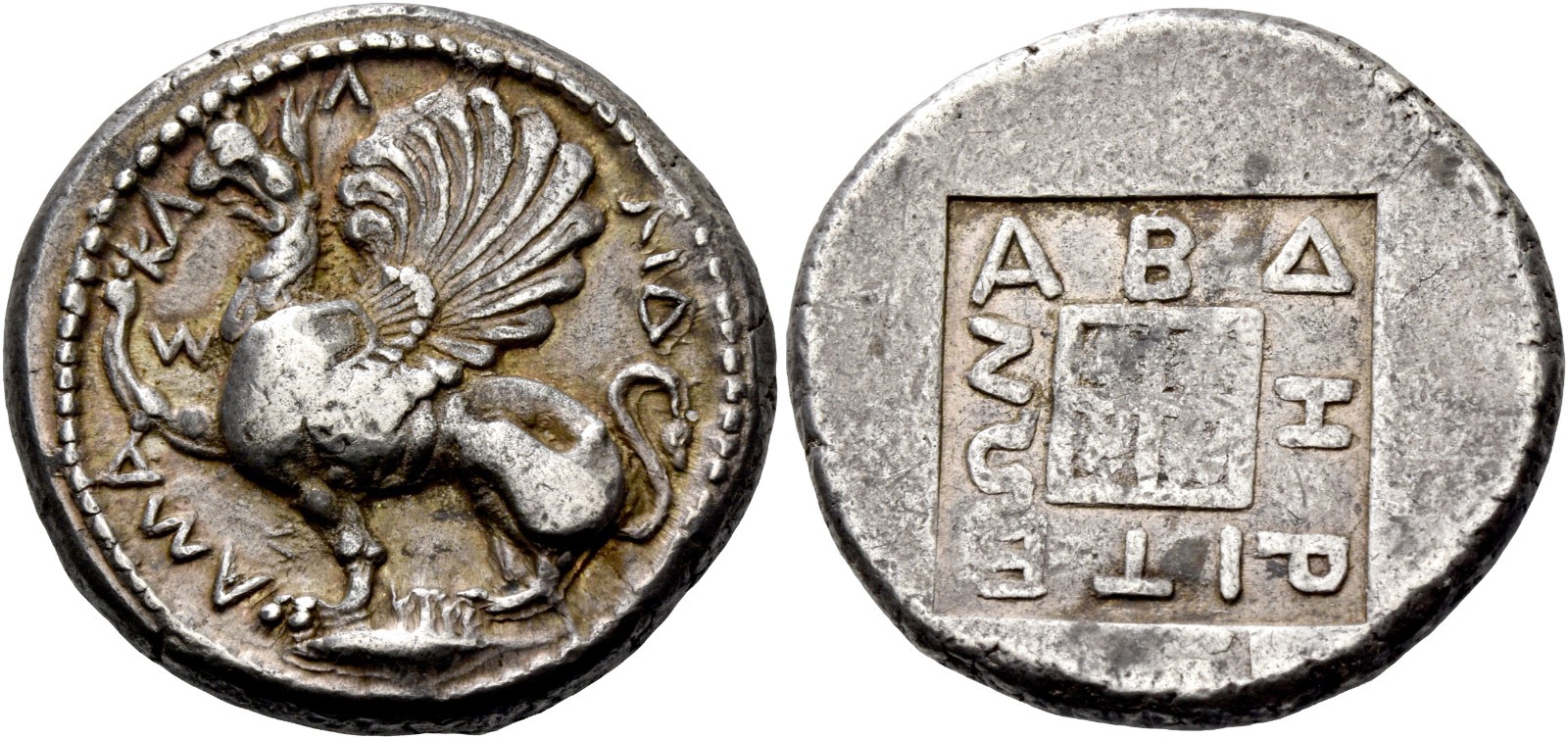Abdera, silver, tetradrachms (griffin/ethnic in incuse square) (439/7-411/10 BCE)
From SILVER
439 BCE - 410 BCE Silver 6,978 kg
Description
| ObverseInscription or printing placed on the obverse.: | KA – Λ – ΛIΔ – AMA – Σ (Greek).Griffin seated l., with rounded wings, r. foreleg raised, below, tunny. |
| ReverseInscription or printing placed on the reverse.: | ABΔ – HP – ITE – ΩN (Greek).Inscription around the border of an incuse square, within which, a quadripartite square. |
Mint and issuing power
| MintIdentifies the place of manufacture or issue of a numismatic object.: | Abdera | Ancient regionAncient region.: | Thrace | Modern countryModern country: Greece | AuthorityIdentifies the issuing power. The authority can be "pretended" when the name or the portrait of X is on the coin but he/she was not the issuing power. It can also be "uncertain" when there is no mention of X on the coin but he/she was the issuing power according to the historical sources: |
Chronology
| FromIdentifies the initial date in a range assigned in a numismatic context. | 439 BCE | toIdentifies the final date in a range assigned in a numismatic context.. | 410 BCE | PeriodTime period of the numismatic object.: Classical 480-323 BC |
Physical description
| MetalThe physical material (usually metal) from which an object is made.: | Silver |
Median weightMedian of the weights of numismatic objects (in grams). in grams | 13.95 | DenominationTerm indicating the value of a numismatic object. Examples: tetradrachm, chalkous, denarius.: | tetradrachm |
StandardStandard.: |
Image

AC105 Abdera.jpeg [1]
References
| Die study referencePublication of the study: | May 19661May 1966, p. 161-176 (Groups LXXI-LXXXVIII) | ||
| Coin series referenceReference to coin series study: | RQEMAC2RQEMAC, n° 105, HGC 33HGC 3, 1158 | ||
Obverse dies distribution
| FrequencyFrequency of specimen in distribution. ᵖ | Number of obversesNumber of obverse dies. ᵖ (o) | % (o) | Number of coinsNumber of coins. (n) | % (n) | Die nameName(s) of the die(s). |
| 1 | 5 | 26.32 | 5 | 9.43 | 164, 165, 179, 183, 186 |
| 2 | 6 | 31.58 | 12 | 22.64 | 163, 166, 167, 168, 175, 184 |
| 3 | 2 | 10.53 | 6 | 11.32 | 176, 180 |
| 4 | 3 | 15.79 | 12 | 22.64 | 177, 182, 185 |
| 5 | 1 | 5.26 | 5 | 9.43 | 181 |
| 6 | 1 | 5.26 | 6 | 11.32 | 178 |
| 7 | 1 | 5.26 | 7 | 13.21 | 187 |
| Total | 19 of 19 | 100 | 53 of 53 | 99.99 |
Reverse dies distribution
no distribution is available
Quantification
| Number of obversesNumber of obverse dies. ᵖ (o) | 19 | Number of singletons (o1)The number of singleton coins. ᵖ | 5 |
| Number of reverse diesNumber of reverse dies. (r) | Number of coinsNumber of coins. (n) | 53 | |
| Coins per obverse dieNumber of coins per obverse die. (n/o) | 2.79 | Coins per reverse dieNumber of coins per reverse die. (n/r) | |
| Reverse per obverse ratioRatio of obverse dies divided by reverse dies. (r/o) | Percentage of singletons (o1)number of coins (n) divided by the number of singletons (o1) ᵖ | 26.32 % | |
| Original number of dies (O) (Carter 1983 formula)The estimation of the number of coins according to Carter 1983 ᵖ | 25.01 | Coins struck if 20,000 as average productivity per dieCoins made if the average productivity for obverses (according to Carter) is 20,000. ᵖ | 500,200 |
| Original number of dies (O) (Esty 2011 formula)The estimation of the number of coins according to the singleton formula in Esty 2011 ᵖ (O) | 29.62 | Survival rate if 20,000 as average productivity per dieSurvival rate if average productivity is 20,000. ᵖ | 0.00011 |
| Coverage (o = % of O) (Esty 1984 formula)Esty 1984 - coverage (% of O) ᵖ (o = % of O) | 90.57% | Die productivity if survival rate 1/2,000Average productivity if survival rate is 1/2,000. ᵖ | 4,238.3 |
| Weight of silver (in kg) if 20,000 coins per die (O = Carter formula)Carter 1983 * Median weight * 20000 (*10 if gold or electrum) ᵖ | 6,978 kg <br /> 6,978 kg | Die productivity if survival rate 1/5,000Average productivity if survival rate is 1/5,000. ᵖ | 10,595.76 |
Remarks
Most likely one single workstation